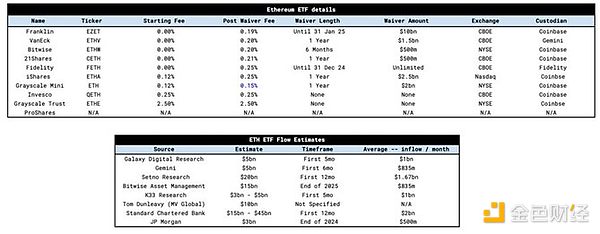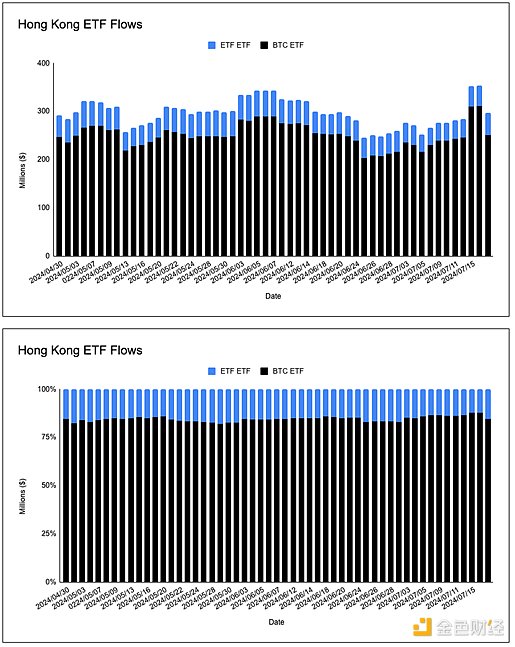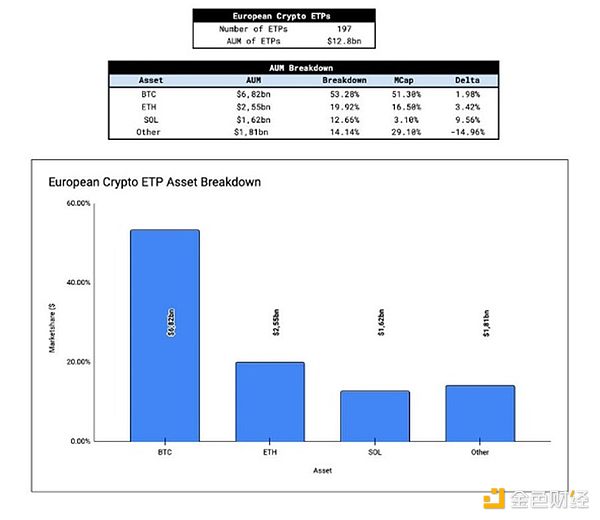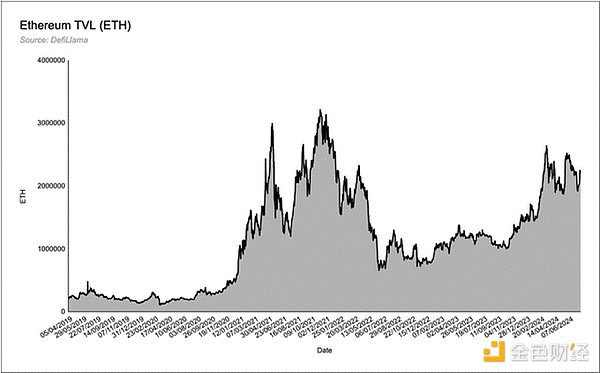Author: ASXN Digital Asset Research, Translator: Golden Finance xiaozou
The Ethereum spot ETF will be launched on July 23. There are many aspects of the ETH ETF that are not visible in the BTC ETF and are easily overlooked by the market.
ETHE Outflow Forecast
ETFs The fee structure of ETFs is similar to that of BTC ETFs. Most ETF providers do not charge any fees during a specific period in order to better accumulate asset management scale. Just like the case with the BTC ETF, Grayscale has maintained its ETHE fee rate at 2.5%, an order of magnitude higher than other providers. The key difference here is the introduction of the Grayscale Mini ETH ETF, which was previously applied for the BTC ETF but was not approved.
This mini trust product is a new ETF product launched by Grayscale, and the initial disclosed fee rate is 0.25%, similar to other ETF providers. Grayscale's idea is to collect 2.5% fees from less active ETHE holders while attracting more active, fee-sensitive ETHE holders to their new product, rather than letting them flow to lower-fee products like Blackrock's ETHA ETF. After other providers lowered their fees by 25bps, Grayscale evened the game by lowering the mini-trust fees to 15bps, making it the most competitive product. On top of that, they transferred 10% of ETHE AUM (Assets Under Management) to the mini-trust and presented this new ETF to ETHE holders. This transition was done on the same basis, meaning it was not a taxable event.
The corresponding impact is that ETHE outflows will be more moderate as holders transition to this mini-trust compared to GBTC.

ETH ETF Inflow Forecast
There are many estimates of ETF inflows, some of which we have highlighted below. Normalizing these estimates gives an average estimate of $1 billion/month. Standard Chartered Bank gives the highest estimate at $2 billion/month, while JP Morgan has a lower estimate of $500 million/month.
Fortunately, we have the help of Hong Kong and European ETPs (Exchange Traded Products), as well as ETHE Discount Close, to help us estimate flows. If we look at the AUM of Hong Kong ETPs, we can draw two conclusions:
(1) The relative AUM of BTC and ETH ETPs is higher than that of BTC vs. ETH, with a relative market capitalization of 75:25 and an AUM of 85:15.
(2) The ratio of BTC to ETH is fairly constant across these ETPs and is consistent with the ratio of BTC market capitalization to ETH market capitalization.

In Europe, we have a much larger sample size to study—197 cryptocurrency ETPs with a cumulative AUM of $12 billion. After our data analysis, we found that the breakdown of AUM of European ETPs is roughly consistent with the market capitalization of Bitcoin and Ethereum. Solana is over-allocated relative to its market cap, at the expense of “other crypto ETPs” (anything but BTC, ETH, or SOL). Solana aside, a pattern is beginning to emerge — the breakdown of AUM between BTC and ETH globally roughly reflects a market cap weighted basket.

Given that GBTC outflows were the genesis of the “sell the news” narrative, it’s important to consider the potential for ETHE outflows. To model potential ETHE outflows and their impact on price, it’s worth looking at the proportion of ETH supply in ETHE.
Once adjusted for Grayscale’s mini-seed capital (10% of ETHE AUM), the proportion of ETH supply as a function of total existing supply in ETHE is similar to GBTC at launch. It is not clear what the rotation vs. exit ratio is for GBTC outflows, but if we assume that rotation flows are in a similar ratio to exit flows, then the impact of ETHE outflows on price is similar to that of GBTC outflows.
Another key piece of information that is overlooked by most is ETHE’s NAV (net asset value) premium/discount. ETHE has been trading in a 2% range to par since May 24th, while GBTC first traded in a 2% range to NAV on January 22nd (just 11 days after GBTC converted to an ETF). The approval of a spot Bitcoin ETF and its impact on GBTC was slowly priced into the market, while the discount of ETHE trading against NAV is more reflected in the existing narrative of GBTC.
When the ETH ETF goes live, ETHE holders will have 2 months to exit at a price range close to par. This is a key variable that will help stem ETHE outflows, especially exit flows.
ASXN’s internal estimate is $800 million to $1.2 billion per month. This is calculated by taking a market cap weighted average of monthly Bitcoin inflows and then multiplying by the market cap of ETH.
Our estimate is supported by global crypto ETP data, which suggests that a market cap weighted basket is the dominant strategy (we may see rotation flows from the BTC ETF, which employs a similar strategy). Additionally, given the unique dynamics of ETHE trading at par prior to launch and the launch of the mini trust, we are open to upside surprises on ETH prices.

Our estimates of ETF inflows are proportional to their respective market caps, so the impact on price should be similar. However, it is also important to measure what percentage of the asset is liquid and can be sold - assuming that the smaller the "flow rate", the more price will react to inflows.
There are two special factors that affect ETH's liquid supply, namely the native stake and the supply in smart contracts. Therefore, ETH has a lower percentage of liquid and saleable than BTC, making it more sensitive to ETF inflows. However, it is worth noting that the liquidity difference between the two assets is not as large as some people believe (ETH's cumulative +-2% order depth is 80% of BTC).
Our approximate calculation of liquid supply:

Ethereum Reflexivity
It is important to understand Ethereum's reflexivity when we study ETFs. The mechanism is similar to BTC, but Ethereum's destruction mechanism and the DeFi ecosystem built on it make the feedback loop more powerful.
The reflexive loop looks like this:
ETH flows into ETH ETF → ETH price rises → interest in ETH rises → DeFi/chain usage rises → DeFi fundamentals improve → EIP-1559 burns increase → ETH supply falls → ETH price rises → more ETH flows into ETH ETF → interest in ETH rises → ...
One thing missing from the BTC ETF is the lack of a "wealth effect" in the ecosystem. In the emerging Bitcoin ecosystem, we don't see a lot of gains being reinvested into base layer projects or protocols. Ethereum, as a "decentralized app store" with a complete ecosystem, will benefit from continued inflows of base assets.
We believe that this wealth effect has not been given enough attention, especially in DeFi. There is 20 million ETH ($63 billion) of TVL in Ethereum DeFi protocols, and as ETH trading goes higher, as TVL and revenues denominated in USD surge, ETH DeFi investment appeal becomes more and more attractive.
ETH has a reflexivity that does not exist in the Bitcoin ecosystem.

Other factors to consider
1. What will be the rotation inflow from BTC ETF to ETH ETF? Assume that a portion of BTC ETF allocators are unwilling to increase their net cryptocurrency exposure, but want to diversify. In particular, TradFi investors prefer market capitalization weighted strategies.
2. How well does TradFi understand ETH assets and the Ethereum smart contract layer? Bitcoin’s “digital gold” narrative is both well understood and well known. How well will Ethereum’s narrative (settlement layer of the digital economy, three-point asset theory, tokenization, etc.) be understood?
3. How will previous market conditions affect ETH’s flow and price action?
4. The elites in the ivory tower have designated two crypto assets as bridges to their worlds – Bitcoin and Ethereum. These assets have crossed the proverbial zeitgeist. How does the launch of a spot ETF change the way TradFi capital allocators view ETH, given that they are now able to offer products that can charge fees. TradFi’s thirst for yield makes Ethereum’s native yield from staking very attractive to providers, and we believe that staking an ETH ETF is an “if” rather than a “when”. Providers can offer 0-fee products and earn an order of magnitude more than normal ETH ETF fees simply by staking ETH on the back end.
 Huang Bo
Huang Bo









